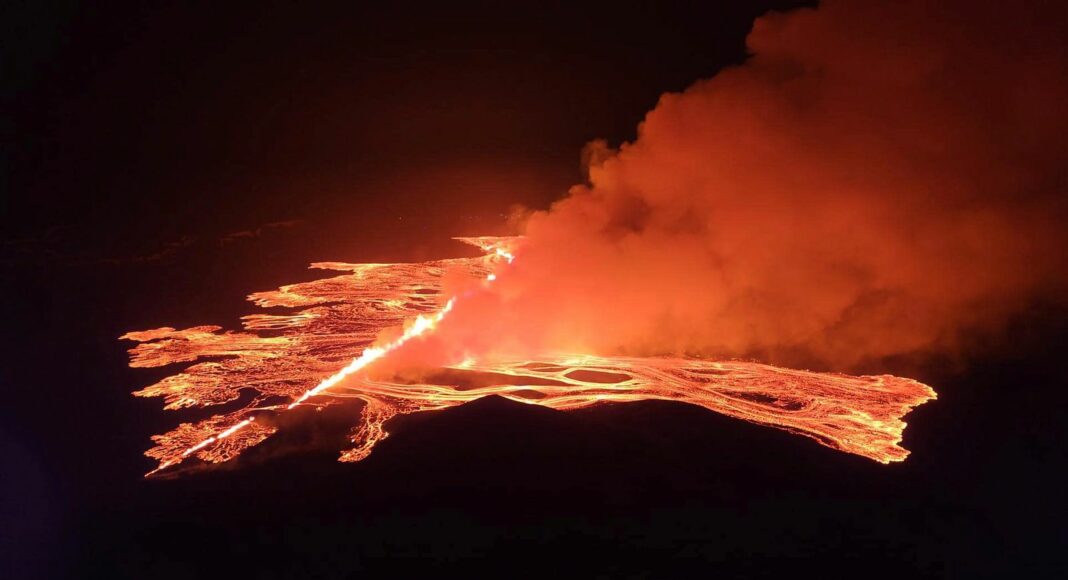A volcano in Iceland has erupted for the fourth time since December after previous eruptions destroyed roads and forced a town to evacuate.
Livestreams from the area showed fountains of molten rock soaring into the night sky from fissures in the ground.
Authorities had warned for weeks that an eruption was imminent on the Reykjanes peninsula, just south of Iceland’s capital Reykjavik.
Image:
The volcano is erupting for the fourth time since December. Pic: Iceland Civil Defense via AP
The Icelandic Meteorological Office confirmed a volcanic eruption started between Stora Skogfell and Hagafell on Saturday evening.
There were no reported flight disruptions on Saturday night, with the website of Reykjavik’s nearby Keflavik Airport showing it remained open both for departures and arrivals.
Image:
The eruption has created a vast lava flow outside the town of Grindavik. Pic: AP/Marco di Marco
In and around the town of Grindavik, where some of the town’s 4,000 residents had returned following earlier outbreaks, police have declared a state of emergency.
Evacuations were taking place, public broadcaster RUV said.
Sky correspondent Alex Crawford was among hundreds of holidaymakers evacuated from the popular Blue Lagoon spa, which lies a short distance northwest of the volcano site.
0:29
Sky correspondent Alex Crawford among tourists evacuated
Image:
The eruption site is around two miles northeast of Grindavik. Pic: Reuters
“We’ve seen a lot of police cars, ambulance cars, and a lot of people trying to get out of the area,” Crawford said, as she was being evacuated from her hotel by bus.
“Everyone has been quite calm and it’s all been quite orderly, they’ve been through this quite a lot recently.
“We’re all being taken to a safer place inland in Reykjavik.”
Image:
The eruption site is around two miles northeast of Grindavik. Pic: Reuters
Grindavik, about 30 miles southwest of Reykjavik, was evacuated in November when the Svartsengi volcanic system awakened after almost 800 years with a series of earthquakes that opened large cracks in the ground north of the town.
The volcano erupted on 18 December, sending lava flowing away from Grindavik.
A second eruption on 14 January sent lava toward the town. Defensive walls that had been bolstered after the first eruption stopped some of the flow but several houses were burned to the ground.
Both eruptions lasted only a matter of days.
0:42
February: Watch lava from volcano reach roads
Image:
Volcanic hot springs of the Blue Lagoon near Grindavik
A third eruption on 8 February cut off district heating to more than 20,000 people as lava flows destroyed roads and pipelines, but it petered out within hours.
Geophysicist Magnus Tumi Gudmundsson was quoted by RUV as saying this latest eruption is the most powerful so far.
The most disruptive in recent times was the 2010 eruption of the Eyjafjallajokull volcano, which spewed huge clouds of ash into the atmosphere and led to widespread airspace closures over Europe.
Read more:The hazard and beauty of volcanoesSearch called off for man who fell into crack in ground after eruption
Image:
Spectators watch plumes of smoke from the latest volcanic activity. Pic: AP/Marco di Marco
Volcanic outbreaks in the Reykjanes peninsula are so-called fissure eruptions, which do not usually cause large explosions or significant dispersal of ash into the stratosphere.
However, scientists fear they could continue for decades, and authorities have started building dykes to divert burning lava flows away from homes and critical infrastructure.




